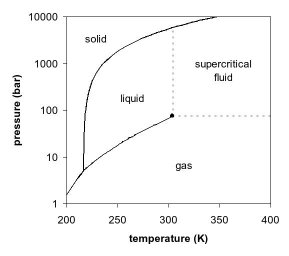Okay, so Jupiter, Saturn, et. al are gas giants. I understand that they have large gassy atmospheres, which, due to the pressure would eventually become more and more dense as one approaches the center of the planet. Falling into Saturn or Jupiter, would we pass through it until we hit the nucleus? hits my model about right – gas eventually compressed by gravity would form, I suppose, a liquid core, followed by a solid surface.
Assuming that Jupiter and Saturn were made of pure hydrogen (It's actually about 90%, but I'll simplify it a bit, how would one go about calculating the distance at which there is a "surface"? Put another way, at some distance, gravity should compress the gas into a liquid, and at a point even lower, I would assume that the liquid would compress into a gas.
Is there an equation that would tell me what those points are?
And, for bonus points, assuming that Saturn has a diameter of 72,367 miles / 116,464 km, at what distances would the transition points from solid to liquid and liquid to gas be?
Full disclosure: I do realize that the same surface pressures would actually implode a human being trying to step on said surface. Despite desires to attempt this in reality, I am not actually going to "try this at home." This is a thought experiment more about how I calculate where gravity forces a compound into a different state of matter. I am curious more about how one models the effect of mass into gravity and compression. As a thought experiment, I suppose technically this is not a 'problem I face,' but I am curious. Thanks in advance 🙂

Best Answer
This might not fully answer your question, but maybe it will be a good start.
Things to consider
For the first 2 items to consider, we actually don't have much of a problem. We could go about figuring out the sun's radiation power (well...on wiki it says $3.846 \times 10^{26}$ if you're interested), estimate the energy received by Jupiter by making a surface area argument and then figuring out Jupiter's radiation power. From this site http://www.tritonfun.com/custom.em?pid=594668, it actually says that Jupiter is radiating 1.9 times the amount of heat it receives from the sun. But this is because it is also creating it's own energy from a variety of methods (including radionuclides). We can ignore all of that though because I'll bet that Jupiter is close to thermal equilibrium in the short term (ie, it's not constantly changing temperature as a whole extremely drastically). If you weren't given the information as to how hot a planet was, this is the kind of analysis you would have to perform in order to get the average temperature of the body. Luckily we can use data from other sources for the temperature of Jupiter.
That addresses points 1 and 2. From a number of online resources, Jupiter has multiple layers, namely, the outer, gaseous atmosphere, a transition area between gas and liquid, a liquid/metallic section and the a mostly hydrogen core. Unfortunately I can't find exact distances of all of these...which would make answering this much easier. But, what we need to know is that the layers differ drastically in terms of pressure and temperature. In fact many layers that are farther from the center of Jupiter are actually hotter, but with less pressure. So the pressure and the temperature combined will affect what phase hydrogen is in. It's extremely complicated and probably well beyond the scope of most physicists to understand why some layers have more pressure than others, but we could just make a vast simplification and say the pressure and temperature increase/decrease as a simple function of distance from the center of Jupiter.
Jupiter's temperature and pressure increase steadily as we get closer and closer to the center only at the core. Near the phase transition region between gas and liquid, the temperature is about 10,000 K and the pressure is 200 Gpa. The temperature at the core's edge is around 36,000 K and 3000-4500 Gpa. So it seems like both temperature and pressure increase throughout the liquid layer/transition layer too. I'm not necessarily sure how to calculate this from scratch, given the elements, the mass of the planet, it's radius and density. Of course it will involve balancing the forces of gravity with electrostatic forces (I just tried a quick calculation using those 2 forces only, but it was WAY off). The fact that my calculation was pretty far off tells me there are a lot more things you have to consider that are extremely important for accuracy. For example, as the hydrogen molecules heat up, they will be bouncing around faster and faster, causing a greater repulsion. Details like this make the calculation very difficult.
I know this doesn't help you a whole lot, but hopefully I've illustrated some important points. Firstly, this kind of calculation (if you want it to be accurate) is something people with PhD's who specialize is this kind of stuff calculate. You can make huge simplifications and maybe get an okay answer. But I feel like it's a wasted effort to actually go through the calculations if they don't give you a very accurate answer. But like I said, if you want to get a rough answer, think about all of the forces going on. Gravity, electrostatic repulsion, average thermal energy, and then make the net force = 0. Electrostatic repulsion of hydrogen can be found on the wiki page and hopefully you know how to take into account gravity as a function of distance from the center =p.